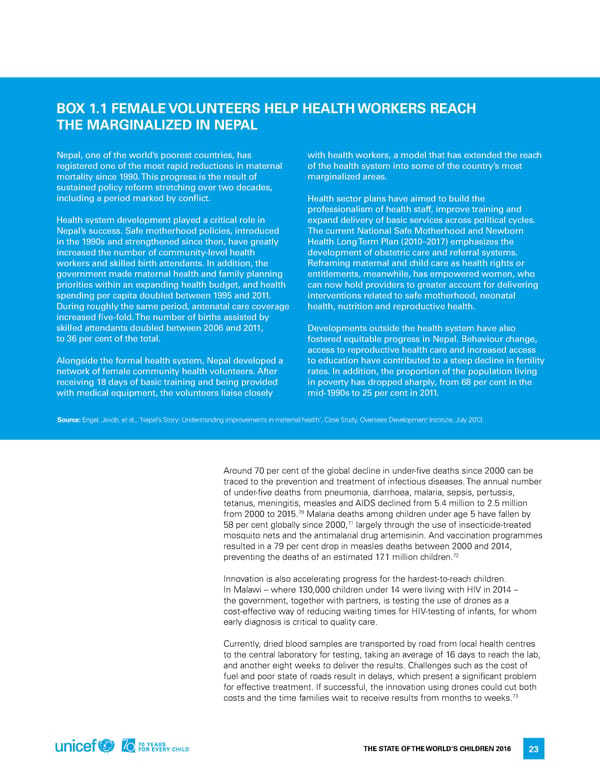BOx 1.1 FEMALE vOLUNTEERS HELP HEALTH WORkERS REACH THE MARGINALIzED IN NEPAL Nepal, one of the world’s poorest countries, has with health workers, a model that has extended the reach registered one of the most rapid reductions in maternal of the health system into some of the country’s most mortality since 1990. This progress is the result of marginalized areas. sustained policy reform stretching over two decades, including a period marked by conflict. Health sector plans have aimed to build the professionalism of health staff, improve training and Health system development played a critical role in expand delivery of basic services across political cycles. Nepal’s success. Safe motherhood policies, introduced The current National Safe Motherhood and Newborn in the 1990s and strengthened since then, have greatly Health Long Term Plan (2010–2017) emphasizes the increased the number of community-level health development of obstetric care and referral systems. workers and skilled birth attendants. In addition, the Reframing maternal and child care as health rights or government made maternal health and family planning entitlements, meanwhile, has empowered women, who priorities within an expanding health budget, and health can now hold providers to greater account for delivering spending per capita doubled between 1995 and 2011. interventions related to safe motherhood, neonatal During roughly the same period, antenatal care coverage health, nutrition and reproductive health. increased five-fold. The number of births assisted by skilled attendants doubled between 2006 and 2011, Developments outside the health system have also to 36 per cent of the total. fostered equitable progress in Nepal. Behaviour change, access to reproductive health care and increased access Alongside the formal health system, Nepal developed a to education have contributed to a steep decline in fertility network of female community health volunteers. After rates. In addition, the proportion of the population living receiving 18 days of basic training and being provided in poverty has dropped sharply, from 68 per cent in the with medical equipment, the volunteers liaise closely mid-1990s to 25 per cent in 2011. Source: engel, Jakob, et al., 'nepal’s Story: Understanding improvements in maternal health', Case Study, overseas development institute, July 2013. around 70 per cent of the global decline in under-five deaths since 2000 can be traced to the prevention and treatment of infectious diseases. The annual number of under-five deaths from pneumonia, diarrhoea, malaria, sepsis, pertussis, tetanus, meningitis, measles and aidS declined from 5.4 million to 2.5 million 70 from 2000 to 2015. Malaria deaths among children under age 5 have fallen by 58 per cent globally since 2000,71 largely through the use of insecticide-treated mosquito nets and the antimalarial drug artemisinin. and vaccination programmes resulted in a 79 per cent drop in measles deaths between 2000 and 2014, 72 preventing the deaths of an estimated 17.1 million children. innovation is also accelerating progress for the hardest-to-reach children. in Malawi – where 130,000 children under 14 were living with hiV in 2014 – the government, together with partners, is testing the use of drones as a cost-effective way of reducing waiting times for hiV-testing of infants, for whom early diagnosis is critical to quality care. Currently, dried blood samples are transported by road from local health centres to the central laboratory for testing, taking an average of 16 days to reach the lab, and another eight weeks to deliver the results. Challenges such as the cost of fuel and poor state of roads result in delays, which present a significant problem for effective treatment. if successful, the innovation using drones could cut both 73 costs and the time families wait to receive results from months to weeks. The STaTe of The World’S Children 2016 23
 70 Years for Every Child Page 37 Page 39
70 Years for Every Child Page 37 Page 39